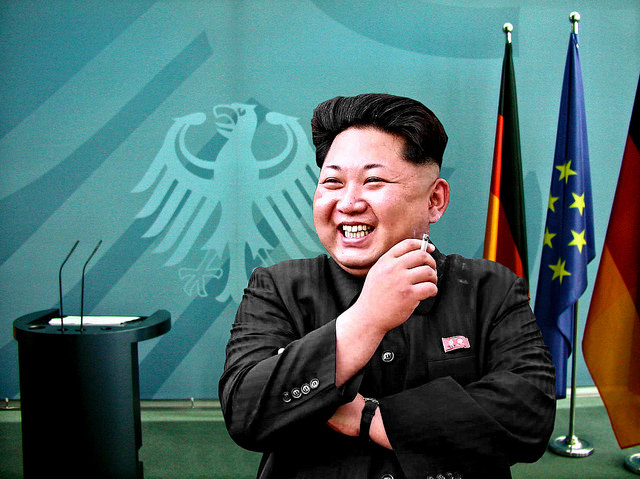Regarding The Prospect of North Korea Causing Disruption with A Biological Weapon
by
James M Wilson V, MD FAAP
Director, Nevada Medical Intelligence Center
School of Community Health Science
University of Nevada-Reno
The prospect of armed conflict with North Korea weighs heavily on all of our minds right now, particularly given that we appear to be dealing with a regime seemingly impervious to diplomacy and international sanctions. While the world is (and should be) primarily concerned with scenarios involving nuclear and conventional weapons engagements, it is worthwhile to pause and consider other scenarios whispered over beers among analysts.
In my world, we fret over the specter of biological weapons. We fret because history has shown us other recalcitrant, isolated regimes who have ignored instruments such as the 1925 Geneva Protocol and 1972 Biological Weapons Convention (BWC). A quick review of the official BWC website does not reassure us that North Korea is a committed signatory (see the number of meetings they have attended in recent years, for example). Most analysts in health security and biodefense consider North Korea to have an offensive biological weapons program. Indeed, history has shown us political instruments like the Geneva Protocol and BWC have proven un-enforceable. Examples include the Germans and Japanese in World War II, the former Soviet Union’s biological warfare program, and recently re-examined allegations of mass-scale biological weapon deployments in Rhodesia in the late 1970s .
Biological weapons can be deployed in a surreptitious manner. While classic military strategists focus on aerosol deployment on the battlefield (or, in the case of the Koreas, across the DMZ) to target military forces, the smart bioweaponeer might take a page from the Japanese Imperial Army’s Unit 731 . Unit 731 viewed biological weapons as a means to disrupt, confuse, or stress the enemy’s civil infrastructure prior to attack with conventional weapons. Under this kind of scenario, any unusual infectious disease activity in South Korea should prompt rapid verification and response.
However, the world continues to have several major problems in a bio-warfare environment. One is determining attribution. While it is generally believed that any confirmed offensive biological weapon deployment would be answered with a nuclear response, this is in reality a difficult policy to execute. The reality is the world of public health has shown us a disturbing inability to proper assess risk, communicate that risk in a well-considered, balanced manner to stakeholders, conduct effective surveillance and response operations, and clearly demonstrate claimed “lessons learned” have indeed been… learned. Recent uncomfortable examples include the 2009 H1N1 influenza pandemic, Ebola disaster, Zika crisis, and the currently unfolding antimicrobial resistance disaster. Credibility in the public health enterprise has been badly eroded, and the world currently lacks an effective health security intelligence system coupled to an effective response mechanism. Biodefense and the instruments of monitoring compliance of the BWC are utterly reliant on public health infrastructure. That infrastructure has shown us, for decades now, that it is overwhelmed, slow to act, and highly resistant to calls for change. In the context of a scenario of North Korean “biological mischief” conducted in South Korea, this is a grave liability.
From the civil medical infrastructure perspective, we have observed South Korea’s public health behave in ways suggestive of lessons not learned in the wake of SARS. During the emergence of SARS, the US military raised serious concerns about whether effective surveillance and response could be conducted in the South Korean civil medical and public health infrastructure… and how that might affect combat effectiveness. This concern was validated during the introduction of MERS to South Korea. During that period, officials were slow to recognize the initial appearance of MERS in South Korea and information was suppressed to avoid anxiety, which impaired effective response. This is a common, unfortunate behavior among Ministries of Health throughout the world when confronted with unusual, non-routine outbreaks.
One may reasonably surmise that the South Korean government will behave in a similar manner in the hypothetical context of an outbreak of unusual, non-routine infectious disease, especially if that disease is associated with unusually high morbidity or mortality. And, particularly if questions of possible biological weapon deployments are raised. As seen with both SARS and MERS, it is impossible for any government to keep these types of crises hidden for long. The public eventually discovers rumors of the situation and takes matters into their own hands, often in response to their government’s lack of transparency. While rare, civil unrest and incendiary violence are potential outcomes in this kind of situation. It is important to note that state failure, however, has not been documented in known history due solely to an outbreak of disease.
So the uncomfortable scenario of a surreptitious deployment of rapidly transmissible disease in a high population dense environment like Seoul indeed could cause a high degree of disruption and distraction in an already politically charged environment. It would be naïve to think that South Korea’s public health and medical infrastructure would behave any differently than we have seen thus far: there will be information suppression and disorganized response with potential for civil unrest. As we saw with the Amerithrax investigation and the aforementioned Rhodesia anthrax epidemic, there is real potential for tremendous delays in proving attribution if North Korea actually did intentionally release a disease in South Korea. This of course assumes attribution could be proven at all. The reality is, there may be little the international community could do to stop such an event from happening, and there may be little the international community could do to prove attribution.
In summary, the world should continue to prioritize the obvious threat of nuclear engagement with North Korea, but also be mindful of alternative scenarios where North Korea could still cause tremendous mischief in the region, including initiating a biologicial attack!


